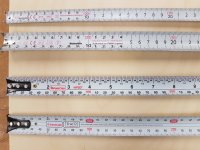rmhinden
Member
DeformedTree said:the problem is the tape measures. For some reason, almost all of them are in cm, no mm. This makes it so easy to screw up when reading it. You want say 236mm. Your brain is expecting things like 100, 200, 300, and then between them. 10, 20, 30 markings, and then 1mm tick marks. So, 200, ->30 -> 6 ticks, but since almost all of them are in cm, you are looking at 10, 20, 30, 1, 2, 3... It just sets up the path for issues.
The only tape I have found in the US that is any good marking wise is the true32 tape. It works correctly (mm). All the rest are in cm, I have messed up a lot with them. As folks know from other threads, I'm very metric, these stupid cm tape measures cause nothing but issues.
I agree. I think I read it somewhere, it's less error prone if you only work in mm. That is, not in cm. It avoids the issues you mention.
I only get rules that are in mm. As you wrote, the FastCap true32 tape is good The Woodpecker metric rules are in mm.
Bob

